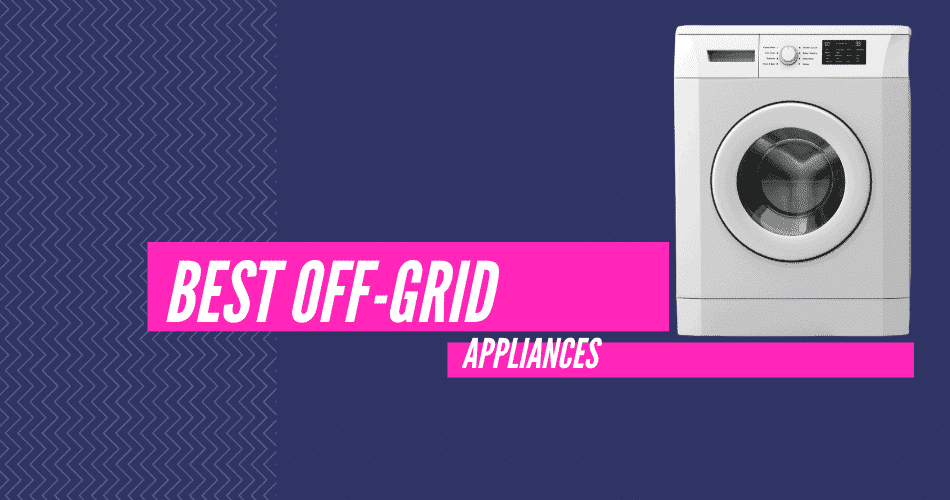Picking out appliances for your off-grid home can be a tricky proposition.
You want to find models that provide performance and convenience without sucking up too much power.
Thankfully, many modern appliances are designed to be as energy-efficient as possible. Even better, lots of great companies are coming out with products specifically designed for use with solar power systems.
Below you’ll find a breakdown of the most common types of off-grid appliances and what features you should look for in each one.
What to Look For in Off-Grid Appliances
Off-grid appliances may look like your average home goods, but they have significant differences in how they’re made and operate.
There are 5 main things to look for include:
- Energy efficiency and power draw
- Water usage
- Ease of maintenance and care
- Required space
- Installation Difficulty
Energy Efficiency and Power Draw
Energy efficiency is one of the most important factors when it comes to off-grid appliances. If you’re running a solar system with a battery bank, there’s a finite amount of power available to you.
Any appliance you consider should be as efficient as possible. A good place to start with electric appliances is to look for an EnergyStar label.
It shows you how much power that particular unit used on average in a year and what level of usage they used to calculate it.
For something like a washing machine, you can find out how much power one load of laundry uses by dividing the total annual power consumption by the number of annual loads they predict.
It isn’t foolproof, but it’s the most reliable way to find the tested power consumption of most appliances, given that many manufacturers don’t list this figure.
Another factor to keep in mind is surge wattage.
Your inverter may be powerful enough to run a particular appliance when it’s at steady-state wattage, but it might not be able to get it there. Surge wattage can be as much as two or even three times steady-state wattage.
Water Usage
Some appliances, specifically washing machines, dishwashers, and hot water heaters, require plumbing connections to work properly. This adds another level of complexity to your home design and can increase your total water usage substantially.
If you’re on a well system, it’s a good idea to find out how much water each system uses per cycle and the rate at which it draws it. You don’t want to overwhelm your well pump and pressure tank.
Ease of Maintenance/Care
The good news from a maintenance perspective is that most off-grid appliances are simply highly-efficient on-grid appliances. There are certainly a few that are purposely built for off-grid usage, but the maintenance, in general, isn’t any more onerous than with traditional home appliances.
And when you’re miles away from civilization, this is a major plus.
Check the manufacturer’s recommendations for specific needs and try to follow general maintenance schedules and guidelines to make your appliances last as long as possible.
Required Space
It may seem obvious, but you need to make sure the appliance you’re considering will fit in your home. This is especially important for people building or buying a tiny home (or any living quarters with limited space) off the grid.
Space is at an absolute premium in that situation, so you need to conserve every inch possible.
For those building cabins or other larger off-grid homes, you’ve got a lot more flexibility. Most major appliances such as stoves/ovens, washing machines, and refrigerators come in pretty standard sizes.
Ovens/stoves, in particular, have several sizes that are standard, starting at 20 inches and going up to about 30”. You can definitely find bigger and smaller models, but you’re going to have to dig a little deeper and you won’t have quite the selection.
Installation Difficulty
Lots of off-grid enthusiasts and tiny dwellers pride themselves on their independent spirit and DIY mentality. With appliance installation, it’s almost always possible to do it yourself, though there are definitely different levels of difficulty for different appliances.
Refrigerators, washing machines, and other primarily electric appliances are the easiest. Most are ‘plug and play’ and require little more than putting them in place and attaching the power cord and water hookups.
Water heaters, and especially gas/propane water heaters, are more involved and complicated.
You have to be confident in your plumbing, wiring, and gas line safety to attempt an installation. It can definitely be done, but you’ll need a lot more tools and the knowledge of how to work safely with gas lines.
The final level is off-grid air conditioners.
I’ll level with you, you should only attempt to install your own AC unit if you’ve got serious DIY skills, as this isn’t a beginner project by any means, and can go wrong quite easily.
It involves wiring, plumbing for drainage, multiple site installations, and the ability to properly pressurize the refrigerant lines.
The exception is a window AC unit, which is pretty much just plug and play.
So now that we have the basics down, let’s dive in to the specific appliances to consider in your off-grid setup.
Off-Grid Refrigerators
Off-grid refrigerators are the appliance most people start with when they’re planning out their solar system and home.
This makes sense when you consider that while you can get by without most other appliances, it is vital to have a way to keep your food cold and fresh.
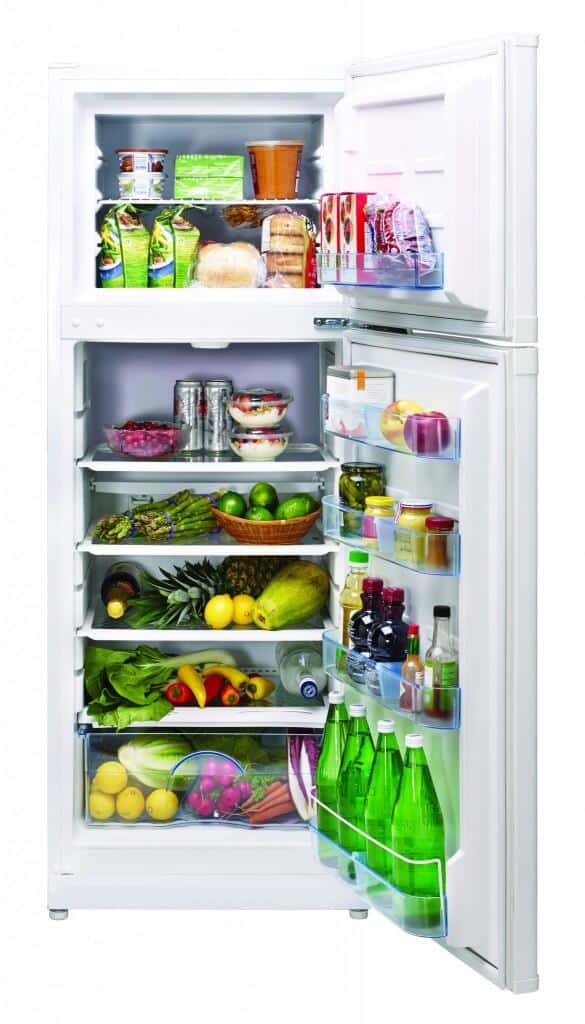
The first things you need to decide is whether you want a traditional electric, DC electric, or propane/natural gas fridge.
There are pros and cons to each variety, and while propane/gas fridges were once the undisputed king, they are now facing stiff competition from both solar electric and DC fridges.
Solar fridges are much more efficient than they once were and provide excellent value for your money.
Propane refrigerators definitely still work, but they’re on the brink of being priced out by solar refrigerators, combined with much more affordable solar power systems.
Average Requirements For Off-Grid Refrigerators
Power Draw/Fuel Usage – 500 to 2,500 watts per day, .5 to 2 lbs of propane/natural gas per day
Water Usage – N/A
Space Required – Varies from fridge to fridge, but the smallest are about the size of dorm-style mini-fridges, all the way up to full-size home models.
Installation Difficulty – Easy for electric, more involved for propane/gas
Care and Maintenance – Same as with a traditional refrigerator
Further reading: I wrote an in-depth article about off-grid refrigerators that I highly recommend reading before you make any purchasing decision.
Off-Grid Washing Machines/Dryers
As more and more of the appliance industry looks for ways to decrease power draw and become more sustainable, the range of quality washers and even dryers available for off-grid enthusiasts has grown.
Gone are the days where your only real option was to hand wash everything.
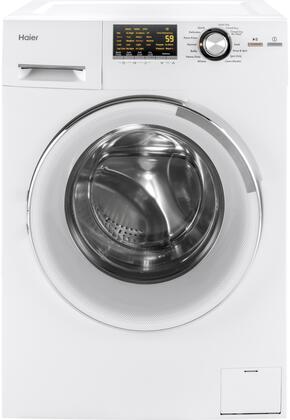
Generally, we recommend you forgo the dryer portion of the washer/dryer setup, as the dryer is almost always the biggest power draw for the system.
You can pick up some really nice washer/dryer combo units that offer excellent efficiency, but it’s still going to use more power than just washing your clothes and hanging them up to dry.
Look for high-efficiency washing machines designed with water and energy-saving features baked in. The best of these can clean an entire load of laundry while using just five gallons of water.
A great option for tiny dwellers looking for a high-efficiency washer is the Beko BWM7200X. It’s compact, uses far less water than most other washers, and is EnergyStar certified as an energy-efficient washer.
If you’re looking to really cut down on your energy and water usage, I highly recommend an innovative little product called The Wonder Wash.
It’s a small plastic capsule that you fill with your clothes, a measure of detergent, and a small amount of water.
It’s hand-cranked and uses no electricity to operate, saving you a ton of money on a solar system and batteries.
You can also compromise with a really neat little washer called the Giantex portable compact twin tub washing machine.
It’s a powered washing machine that separates the washing tub from the spin section to allow you to wash small loads of laundry without the hassle of wringing out water.
Read more by clicking on our blog on dependable off-grid washing machines that won’t break the bank, here.

Average Requirements
Power Draw – 400 to 1300 watts per load
Water Usage – 5 to 30 gallons per load
Space Required – 2.2 to 5+ cubic feet
Installation Difficulty – Beginner, requires both electrical and plumbing hookups, plus drainage pipes and venting for dryers
Care and Maintenance – Basic care is easy, but most modern washers/dryers are difficult to repair on your own
Off-Grid Dishwashers
Unless you’re building out an especially large solar system with ample extra capacity, we don’t recommend you include a dishwasher in your appliance list.
The costs vs benefits tend to fall pretty heavily in the costs category for most cases.
The biggest reason for this is the marginal utility of a dishwasher compared to most other appliances on this list.
Washing dishes can be a pain, but it isn’t especially difficult compared to washing them in a dishwasher.
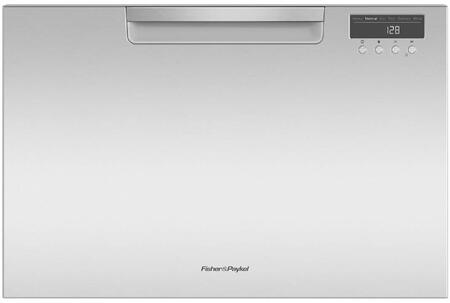
Then there’s the fact that dishwashers tend to have one of the highest power draws in the most concentrated periods of time. Dishwashers draw an average of 1,800 to 2,400 watts an hour for a standard washing cycle.
They also draw a substantial amount of water, requiring full plumbing connections.
If you’re on well water that can lead to increased power draw as your pump works harder while the dishwasher runs.
If you absolutely want a dishwasher we recommend you go for a draw model. These are smaller, more energy-efficient, and generally easier to fit into an off-grid home and power system. Fisher & Paykel make several excellent and high-efficient models that meet these criteria, though they are relatively expensive.
Even still though, their best models still average around 700 watts per load of dishes washed.
Average Requirements
Power Draw – 700 to 1,500 watts per load
Water Usage – 4 to 6 gallons per load
Space Required – Built-in models 24” x 24” x 35”, Drawer models 24” x 24” x 19”
Installation Difficulty – Intermediate. Requires both electricity and plumbing hookups, generally recommend professional installation
Care and Maintenance – Experts recommend a monthly cleaning, with periodic maintenance based on manufacturer recommendations.
For more information on how to save energy in your kitchen, click to learn more.
Off-Grid Air Conditioners
Air conditioners are the creme de la creme of off-grid appliances. They’re the last appliance you’ll probably buy after picking up more ‘practical’ ones like stoves, refrigerators, and washing machines.
First things first, air conditioning while living off the grid requires a lot of power.
Even the most energy-efficient air conditioners are going to pull a significant amount of power, especially in the initial surge as they start up the compressor.

Then there’s how long air conditioners operate for. Things like stoves, ovens, and even washing machines may have similar hourly power draws to air conditioners, but they aren’t run for long periods of time.
If your climate is one where you’ll benefit from an air conditioner, there’s a good chance it will run for a substantial portion of the day.
With that out of the way, we can confidently say that it is possible to have an air conditioner in an off-grid home.
You’ll need to look for extremely high-efficiency air conditioners and especially those that are designed for very small spaces.
You should also keep in mind if your space can be effectively cooled. Heating and cooling power is measured in British Thermal Units (BTUs).
For the purposes of off-grid living, and especially tiny house off-grid living, you can focus on the lower end of the scale starting around 8,000 BTUs and going up to about 12,000-15,000 BTUs.
Any more than that and it becomes increasingly impossible to run on solar.
Mini-split AC units are our top choice, closely followed by window AC units then portable AC units.
The window units are actually a little more efficient than mini-split units, but they have several significant usability and aesthetic issues that can be a problem.
Mini-split AC units offer the next best efficiency for single room air conditioning.
Average Requirements
Power Draw – 400 to 1,000+ Watts per hour
Water Usage – N/A
Space Required – No floor space, but does require wall mounting and the ability to access an outdoor unit or window for a window unit
Installation Difficulty – Advanced. You need to be very confident in your skills as a DIYer to attempt an air conditioner installation unless you’re going with a window AC unit
Care and Maintenance – Moderate. You should dust and wipe the cents, coils, and other accessible points regularly, and have more significant maintenance performed annually.
Looking to set up your own off-grid air conditioning unit? Check out our DIY guide on how to set up your off-grid air conditioning unit.
Off-Grid Stove/Oven
There are lots of great choices for off-grid stoves and ovens.
You can theoretically run an electric range and oven, but there’s basically no reason you should do so.
Heating is one of the most energy-intensive electric processes. And when you consider that there is a wide range of excellent propane/natural gas stoves and ovens to choose from, I highly recommend going away from the electric route.
With stoves, you primarily need to look at the size and the BTU rating.
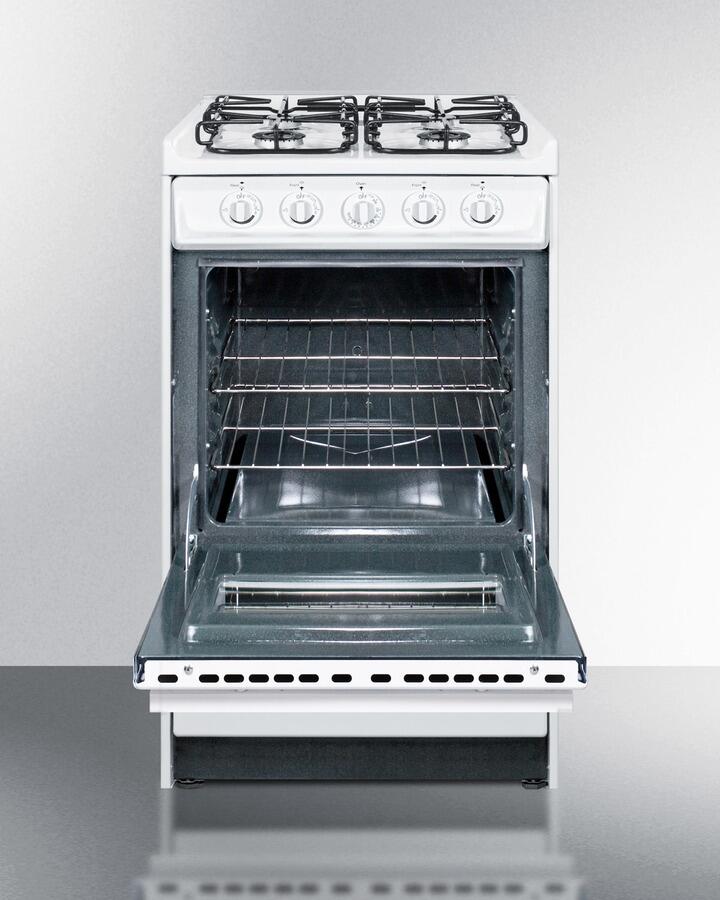
Stoves come in a pretty standard range of sizes, with full-size models coming in at 30” wide, and many smaller ones designed for RV use much smaller.
If you’re building an off-grid home, you should be fine with a residential size model, though tiny homes will often benefit from the more compact RV units.
The BTU rating really comes down to how you see yourself cooking.
We recommend picking up a more powerful stove. The biggest reason for this is that you can almost always run the flame at a lower level to use much less gas and produce less heat, while still having the greater BTUs available when you need them.
Average Requirements
Power Draw – High. We recommend going with a gas range and oven combo
Water Usage – N/A
Space Required – From standard 36” x 30” x 24” to small RV/Tiny house ovens
Installation Difficulty – Beginner (But nerve wracking), the installation process is straightforward but you need to be confident in your ability to work with gas lines safely
Care and Maintenance – Standard cleanup between uses plus periodic checks for gas line integrity
Off-Grid Water Heater
Off-grid water heaters are one of the best upgrades you can make to your home from a comfort perspective.
Your major choices here are electric vs gas/propane and tanked vs tankless.
For my two cents, I recommend you go with a tankless gas/propane system.
They’re more expensive up front, but they offer substantial efficiency savings in the long run.
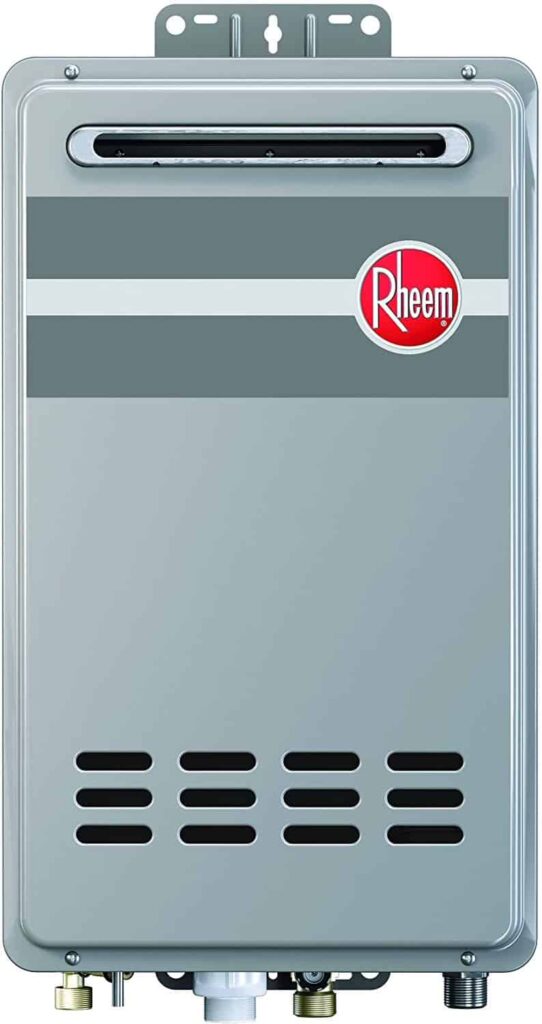
Electric water heaters are power hogs and have a significant starting surge for the tankless models.
If you don’t have propane or natural gas already at your home, it may not be worth it to get just for your water heater, but given that it’s the best fuel option for many different heat-related appliances, I highly recommend you do.
I recommend tankless gas water heaters for a number of benefits they provide. They’re smaller, lighter, easier to install, don’t have a continuous fuel/power draw to keep water at temperature, and are fully compatible with well systems.
At this point, a tankless system, electric or gas operated, should be the way you go.
Check out my full category overview and review to find some of the best propane tankless water heaters for tiny dwellers and off-grid living.
In the article, I ranked the top 7 water heaters. So if you’re looking for a solid water heater at a great price, I highly suggest checking it out.
Average Requirements
Power Draw – Very high, over several kilowatts per day of use. Propane/gas consumption will vary depending on region and usage, but it has a much lower power use.
Water Usage – Dependent on your water needs
Space Required – Very small for exterior mounted tankless systems
Installation Difficulty – Advanced. Installing a water heater requires plumbing and gas line connections, plus the physical installation process itself
Care and Maintenance – Minimal, basic care needed annually
Final Thoughts
As you can see, the off-grid appliance market is varied and thriving.
Some appliances lend themselves to off-grid life better than others, but so long as you’ve got the power and the budget, there’s an option available for every type of appliance you could desire

